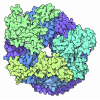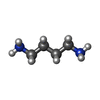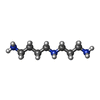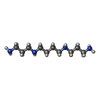+ データを開く
データを開く
- 基本情報
基本情報
| 登録情報 |  | |||||||||
|---|---|---|---|---|---|---|---|---|---|---|
| タイトル | Human 60S ribosomal subunit | |||||||||
 マップデータ マップデータ | Cryo-EM reconstruction of the HeLa large ribosomal subunit. | |||||||||
 試料 試料 |
| |||||||||
 キーワード キーワード | Large ribosomal subunit / HeLa / modifications / polyamines / RIBOSOME | |||||||||
| 機能・相同性 |  機能・相同性情報 機能・相同性情報translation at presynapse / exit from mitosis / eukaryotic 80S initiation complex / negative regulation of protein neddylation / optic nerve development / response to insecticide / regulation of translation involved in cellular response to UV / axial mesoderm development / negative regulation of formation of translation preinitiation complex / regulation of G1 to G0 transition ...translation at presynapse / exit from mitosis / eukaryotic 80S initiation complex / negative regulation of protein neddylation / optic nerve development / response to insecticide / regulation of translation involved in cellular response to UV / axial mesoderm development / negative regulation of formation of translation preinitiation complex / regulation of G1 to G0 transition / ribosomal protein import into nucleus / protein-DNA complex disassembly / 90S preribosome assembly / positive regulation of intrinsic apoptotic signaling pathway in response to DNA damage by p53 class mediator / retinal ganglion cell axon guidance / GAIT complex / positive regulation of DNA damage response, signal transduction by p53 class mediator / TORC2 complex binding / alpha-beta T cell differentiation / G1 to G0 transition / middle ear morphogenesis / cytoplasmic side of rough endoplasmic reticulum membrane / negative regulation of ubiquitin protein ligase activity / homeostatic process / macrophage chemotaxis / lung morphogenesis / male meiosis I / positive regulation of natural killer cell proliferation / Protein hydroxylation / Peptide chain elongation / Selenocysteine synthesis / Formation of a pool of free 40S subunits / Eukaryotic Translation Termination / ubiquitin ligase inhibitor activity / cellular response to actinomycin D / blastocyst development / Response of EIF2AK4 (GCN2) to amino acid deficiency / SRP-dependent cotranslational protein targeting to membrane / negative regulation of ubiquitin-dependent protein catabolic process / positive regulation of signal transduction by p53 class mediator / Viral mRNA Translation / Nonsense Mediated Decay (NMD) independent of the Exon Junction Complex (EJC) / protein localization to nucleus / GTP hydrolysis and joining of the 60S ribosomal subunit / L13a-mediated translational silencing of Ceruloplasmin expression / positive regulation of protein binding / Major pathway of rRNA processing in the nucleolus and cytosol / protein targeting / protein-RNA complex assembly / Nonsense Mediated Decay (NMD) enhanced by the Exon Junction Complex (EJC) / maturation of LSU-rRNA / rough endoplasmic reticulum / Maturation of protein E / Maturation of protein E / MDM2/MDM4 family protein binding / ER Quality Control Compartment (ERQC) / negative regulation of proteasomal ubiquitin-dependent protein catabolic process / Myoclonic epilepsy of Lafora / FLT3 signaling by CBL mutants / Prevention of phagosomal-lysosomal fusion / IRAK2 mediated activation of TAK1 complex / Alpha-protein kinase 1 signaling pathway / Glycogen synthesis / IRAK1 recruits IKK complex / IRAK1 recruits IKK complex upon TLR7/8 or 9 stimulation / Endosomal Sorting Complex Required For Transport (ESCRT) / Membrane binding and targetting of GAG proteins / embryo implantation / Negative regulation of FLT3 / Regulation of TBK1, IKKε (IKBKE)-mediated activation of IRF3, IRF7 / PTK6 Regulates RTKs and Their Effectors AKT1 and DOK1 / Regulation of TBK1, IKKε-mediated activation of IRF3, IRF7 upon TLR3 ligation / Constitutive Signaling by NOTCH1 HD Domain Mutants / IRAK2 mediated activation of TAK1 complex upon TLR7/8 or 9 stimulation / cytosolic ribosome / NOTCH2 Activation and Transmission of Signal to the Nucleus / TICAM1,TRAF6-dependent induction of TAK1 complex / TICAM1-dependent activation of IRF3/IRF7 / APC/C:Cdc20 mediated degradation of Cyclin B / Downregulation of ERBB4 signaling / Regulation of FZD by ubiquitination / cellular response to interleukin-4 / APC-Cdc20 mediated degradation of Nek2A / p75NTR recruits signalling complexes / InlA-mediated entry of Listeria monocytogenes into host cells / TRAF6 mediated IRF7 activation in TLR7/8 or 9 signaling / TRAF6-mediated induction of TAK1 complex within TLR4 complex / Regulation of pyruvate metabolism / NF-kB is activated and signals survival / ossification / Regulation of innate immune responses to cytosolic DNA / Downregulation of ERBB2:ERBB3 signaling / Pexophagy / NRIF signals cell death from the nucleus / VLDLR internalisation and degradation / Regulation of PTEN localization / Activated NOTCH1 Transmits Signal to the Nucleus / Regulation of BACH1 activity / Synthesis of active ubiquitin: roles of E1 and E2 enzymes / MAP3K8 (TPL2)-dependent MAPK1/3 activation 類似検索 - 分子機能 | |||||||||
| 生物種 |  Homo sapiens (ヒト) Homo sapiens (ヒト) | |||||||||
| 手法 | 単粒子再構成法 / クライオ電子顕微鏡法 / 解像度: 1.78 Å | |||||||||
 データ登録者 データ登録者 | Wiechert F / Schacherl M / Sprink T | |||||||||
| 資金援助 |  ドイツ, 1件 ドイツ, 1件
| |||||||||
 引用 引用 |  ジャーナル: Nucleic Acids Res / 年: 2025 ジャーナル: Nucleic Acids Res / 年: 2025タイトル: Visualizing the modification landscape of the human 60S ribosomal subunit at close to atomic resolution. 著者: Franziska Wiechert / Anett Unbehaun / Thiemo Sprink / Helena Seibel / Jörg Bürger / Justus Loerke / Thorsten Mielke / Christoph A Diebolder / Magdalena Schacherl / Christian M T Spahn /  要旨: Chemical modifications of ribosomal RNAs (rRNAs) and proteins expand their topological repertoire, and together with the plethora of bound ligands, fine-tune ribosomal function. Detailed knowledge of ...Chemical modifications of ribosomal RNAs (rRNAs) and proteins expand their topological repertoire, and together with the plethora of bound ligands, fine-tune ribosomal function. Detailed knowledge of this natural composition provides important insights into ribosome genesis and function and clarifies some aspects of ribosomopathies. The discovery of new structural properties and functional aspects of ribosomes has gone hand in hand with cryo-electron microscopy (cryo-EM) and its technological development. In line with the ability to visualize atomic details - a prerequisite for identifying chemical modifications and ligands in cryo-EM maps - in this work we present the structure of the 60S ribosomal subunit from HeLa cells at the very high global resolution of 1.78 Å. We identified 113 rRNA modifications and four protein modifications including uL2-Hisβ-ox216, which stabilizes the local structure near the peptidyl transferase centre via an extended hydrogen-bonding network. We can differentiate metal ions Mg2+ and K+, polyamines spermine, spermidine and putrescine and identify thousands of water molecules binding to the 60S subunit. Approaching atomic resolution cryo-EM has become a powerful tool to examine fine details of macromolecular structures that will expand our knowledge about translation and other biological processes in the future and assess the variability of the chemical space due to differences between species/tissues or varying physicochemical environment. | |||||||||
| 履歴 |
|
- 構造の表示
構造の表示
| 添付画像 |
|---|
- ダウンロードとリンク
ダウンロードとリンク
-EMDBアーカイブ
| マップデータ |  emd_18765.map.gz emd_18765.map.gz | 867.4 MB |  EMDBマップデータ形式 EMDBマップデータ形式 | |
|---|---|---|---|---|
| ヘッダ (付随情報) |  emd-18765-v30.xml emd-18765-v30.xml emd-18765.xml emd-18765.xml | 70.5 KB 70.5 KB | 表示 表示 |  EMDBヘッダ EMDBヘッダ |
| FSC (解像度算出) |  emd_18765_fsc.xml emd_18765_fsc.xml | 21.1 KB | 表示 |  FSCデータファイル FSCデータファイル |
| 画像 |  emd_18765.png emd_18765.png | 69 KB | ||
| マスクデータ |  emd_18765_msk_1.map emd_18765_msk_1.map | 1000 MB |  マスクマップ マスクマップ | |
| Filedesc metadata |  emd-18765.cif.gz emd-18765.cif.gz | 16.8 KB | ||
| その他 |  emd_18765_half_map_1.map.gz emd_18765_half_map_1.map.gz emd_18765_half_map_2.map.gz emd_18765_half_map_2.map.gz | 926.2 MB 925.8 MB | ||
| アーカイブディレクトリ |  http://ftp.pdbj.org/pub/emdb/structures/EMD-18765 http://ftp.pdbj.org/pub/emdb/structures/EMD-18765 ftp://ftp.pdbj.org/pub/emdb/structures/EMD-18765 ftp://ftp.pdbj.org/pub/emdb/structures/EMD-18765 | HTTPS FTP |
-検証レポート
| 文書・要旨 |  emd_18765_validation.pdf.gz emd_18765_validation.pdf.gz | 1.1 MB | 表示 |  EMDB検証レポート EMDB検証レポート |
|---|---|---|---|---|
| 文書・詳細版 |  emd_18765_full_validation.pdf.gz emd_18765_full_validation.pdf.gz | 1.1 MB | 表示 | |
| XML形式データ |  emd_18765_validation.xml.gz emd_18765_validation.xml.gz | 31.1 KB | 表示 | |
| CIF形式データ |  emd_18765_validation.cif.gz emd_18765_validation.cif.gz | 40.8 KB | 表示 | |
| アーカイブディレクトリ |  https://ftp.pdbj.org/pub/emdb/validation_reports/EMD-18765 https://ftp.pdbj.org/pub/emdb/validation_reports/EMD-18765 ftp://ftp.pdbj.org/pub/emdb/validation_reports/EMD-18765 ftp://ftp.pdbj.org/pub/emdb/validation_reports/EMD-18765 | HTTPS FTP |
-関連構造データ
| 関連構造データ |  8qyxMC M: このマップから作成された原子モデル C: 同じ文献を引用 ( |
|---|---|
| 類似構造データ | 類似検索 - 機能・相同性  F&H 検索 F&H 検索 |
- リンク
リンク
| EMDBのページ |  EMDB (EBI/PDBe) / EMDB (EBI/PDBe) /  EMDataResource EMDataResource |
|---|---|
| 「今月の分子」の関連する項目 |
- マップ
マップ
| ファイル |  ダウンロード / ファイル: emd_18765.map.gz / 形式: CCP4 / 大きさ: 1000 MB / タイプ: IMAGE STORED AS FLOATING POINT NUMBER (4 BYTES) ダウンロード / ファイル: emd_18765.map.gz / 形式: CCP4 / 大きさ: 1000 MB / タイプ: IMAGE STORED AS FLOATING POINT NUMBER (4 BYTES) | ||||||||||||||||||||||||||||||||||||
|---|---|---|---|---|---|---|---|---|---|---|---|---|---|---|---|---|---|---|---|---|---|---|---|---|---|---|---|---|---|---|---|---|---|---|---|---|---|
| 注釈 | Cryo-EM reconstruction of the HeLa large ribosomal subunit. | ||||||||||||||||||||||||||||||||||||
| 投影像・断面図 | 画像のコントロール
画像は Spider により作成 | ||||||||||||||||||||||||||||||||||||
| ボクセルのサイズ | X=Y=Z: 0.616 Å | ||||||||||||||||||||||||||||||||||||
| 密度 |
| ||||||||||||||||||||||||||||||||||||
| 対称性 | 空間群: 1 | ||||||||||||||||||||||||||||||||||||
| 詳細 | EMDB XML:
|
-添付データ
-マスク #1
| ファイル |  emd_18765_msk_1.map emd_18765_msk_1.map | ||||||||||||
|---|---|---|---|---|---|---|---|---|---|---|---|---|---|
| 投影像・断面図 |
| ||||||||||||
| 密度ヒストグラム |
-ハーフマップ: Cryo-EM reconstruction of the HeLa large ribosomal subunit....
| ファイル | emd_18765_half_map_1.map | ||||||||||||
|---|---|---|---|---|---|---|---|---|---|---|---|---|---|
| 注釈 | Cryo-EM reconstruction of the HeLa large ribosomal subunit. (Half map B) | ||||||||||||
| 投影像・断面図 |
| ||||||||||||
| 密度ヒストグラム |
-ハーフマップ: Cryo-EM reconstruction of the HeLa large ribosomal subunit....
| ファイル | emd_18765_half_map_2.map | ||||||||||||
|---|---|---|---|---|---|---|---|---|---|---|---|---|---|
| 注釈 | Cryo-EM reconstruction of the HeLa large ribosomal subunit. (Half map A) | ||||||||||||
| 投影像・断面図 |
| ||||||||||||
| 密度ヒストグラム |
- 試料の構成要素
試料の構成要素
+全体 : Human mature large ribosomal subunit
+超分子 #1: Human mature large ribosomal subunit
+分子 #1: Large ribosomal subunit protein uL30
+分子 #2: 60S ribosomal protein L7a
+分子 #3: 60S ribosomal protein L9
+分子 #4: Ribosomal protein uL16-like
+分子 #5: 60S ribosomal protein L11
+分子 #6: 60S ribosomal protein L13
+分子 #7: 60S ribosomal protein L14
+分子 #8: 60S ribosomal protein L15
+分子 #9: 60S ribosomal protein L13a
+分子 #10: 60S ribosomal protein L17
+分子 #11: 60S ribosomal protein L18
+分子 #12: 60S ribosomal protein L19
+分子 #13: 60S ribosomal protein L18a
+分子 #14: 60S ribosomal protein L21
+分子 #15: 60S ribosomal protein L22
+分子 #16: 60S ribosomal protein L23
+分子 #17: 60S ribosomal protein L24
+分子 #18: 60S ribosomal protein L23a
+分子 #19: 60S ribosomal protein L26
+分子 #20: 60S ribosomal protein L27
+分子 #21: Large ribosomal subunit protein uL15
+分子 #22: 60S ribosomal protein L29
+分子 #23: 60S ribosomal protein L30
+分子 #24: 60S ribosomal protein L31
+分子 #25: 60S ribosomal protein L32
+分子 #26: 60S ribosomal protein L35a
+分子 #27: 60S ribosomal protein L34
+分子 #28: 60S ribosomal protein L35
+分子 #29: 60S ribosomal protein L36
+分子 #30: 60S ribosomal protein L37
+分子 #31: 60S ribosomal protein L38
+分子 #32: 60S ribosomal protein L39
+分子 #33: Large ribosomal subunit protein eL40
+分子 #34: 60S ribosomal protein L36a
+分子 #35: 60S ribosomal protein L37a
+分子 #36: 60S ribosomal protein L28
+分子 #40: Large ribosomal subunit protein uL2
+分子 #41: Large ribosomal subunit protein uL3
+分子 #42: 60S ribosomal protein L4
+分子 #43: 60S ribosomal protein L5
+分子 #44: 60S ribosomal protein L6
+分子 #37: 28S rRNA
+分子 #38: 5S rRNA
+分子 #39: 5.8S rRNA
+分子 #45: MAGNESIUM ION
+分子 #46: 1,4-DIAMINOBUTANE
+分子 #47: POTASSIUM ION
+分子 #48: ZINC ION
+分子 #49: SPERMIDINE
+分子 #50: SPERMINE
+分子 #51: ADENOSINE-5'-TRIPHOSPHATE
+分子 #52: water
-実験情報
-構造解析
| 手法 | クライオ電子顕微鏡法 |
|---|---|
 解析 解析 | 単粒子再構成法 |
| 試料の集合状態 | particle |
- 試料調製
試料調製
| 濃度 | 0.4583 mg/mL |
|---|---|
| 緩衝液 | pH: 7.5 |
| グリッド | モデル: Quantifoil R2/2 / 材質: COPPER / メッシュ: 200 / 支持フィルム - 材質: CARBON / 支持フィルム - トポロジー: HOLEY / 支持フィルム - Film thickness: 2 / 前処理 - タイプ: GLOW DISCHARGE / 前処理 - 時間: 20 sec. / 前処理 - 雰囲気: AIR / 前処理 - 気圧: 0.037 kPa 詳細: Operated at 15 mA, easiGlow Discharge Cleaning system (PELCO) |
| 凍結 | 凍結剤: ETHANE / チャンバー内湿度: 85 % / チャンバー内温度: 277 K / 装置: FEI VITROBOT MARK IV |
| 詳細 | Hela 60S ribosomal subunits were isolated from cytoplasmic extracts of Hela cells, involving puromycin treatment and sucrose gradient centrifugation in high salt. The gradients were manually fractionated, and separated peak fractions of 60S subunits were collected. For buffer exchange, the sample was diluted 6 x in buffer F (20 mM HEPES pH7.5, 10 mM KCl, 2 mM MgCl2, 2 mM DTT) supplemented with 8.56 % sucrose to adjust the sucrose in the storage buffer to 12%, respectively. Finally, the 60S subunit suspension was concentrated on Amicon Ultracel filter units with a 10 kDa cutoff (Merck Millipore) was snap frozen in 10 ul aliquots and stored at -80 degrees Celsius. Concentrated Hela 60S ribosomal subunits were diluted to 200 nM in buffer E (20 mM HEPES pH7.5, 2 mM MgCl2, 90 mM KCl, 0.5 mM Spermidine, 0.04 mM Spermine, 2 mM DTT) and 4 ul were spotted onto glow-discharged holey carbon grids coated with a continuous thin carbon film (Quantifoil Cu200 R2/2+) and incubated for 40 sec at 4 degrees CelsiusC, 85% RH. The excess of liquid was blotted away for 2 sec and the grids were plunge frozen using the Vitrobot Mark IV (Thermo Fischer Scientific). |
- 電子顕微鏡法
電子顕微鏡法
| 顕微鏡 | FEI TITAN KRIOS |
|---|---|
| 温度 | 最低: 80.0 K / 最高: 82.0 K |
| 撮影 | フィルム・検出器のモデル: GATAN K3 BIOQUANTUM (6k x 4k) デジタル化 - サイズ - 横: 11520 pixel / デジタル化 - サイズ - 縦: 8184 pixel / 撮影したグリッド数: 1 / 実像数: 16983 / 平均電子線量: 49.0 e/Å2 |
| 電子線 | 加速電圧: 300 kV / 電子線源:  FIELD EMISSION GUN FIELD EMISSION GUN |
| 電子光学系 | C2レンズ絞り径: 50.0 µm / 照射モード: FLOOD BEAM / 撮影モード: BRIGHT FIELD / Cs: 2.7 mm / 最大 デフォーカス(公称値): 2.5 µm / 最小 デフォーカス(公称値): 0.5 µm / 倍率(公称値): 105000 |
| 試料ステージ | 試料ホルダーモデル: FEI TITAN KRIOS AUTOGRID HOLDER ホルダー冷却材: NITROGEN |
| 実験機器 |  モデル: Titan Krios / 画像提供: FEI Company |
+ 画像解析
画像解析
-原子モデル構築 1
| 初期モデル | PDB ID: Chain - Source name: PDB / Chain - Initial model type: experimental model |
|---|---|
| 詳細 | Interactive model building was performed in Coot using an auto sharpened map in cryoSPARC and additionally a low-pass-filtered map to 4 Angstrom for the more mobile regions of the 60S structure. Each residue of the model was checked individually for modifications and adjusted manually with a subsequent refinement in phenix.refine. Polyamines and metals were added while searching for unmodelled blobs in Coot. Water molecules were added using phenix.douse and visually validated in Coot. The model was validated using Molprobity. |
| 精密化 | 空間: REAL / プロトコル: OTHER 当てはまり具合の基準: Cross-correlation coefficient |
| 得られたモデル |  PDB-8qyx: |
 ムービー
ムービー コントローラー
コントローラー































 Z (Sec.)
Z (Sec.) Y (Row.)
Y (Row.) X (Col.)
X (Col.)



















































